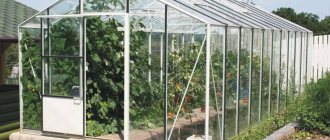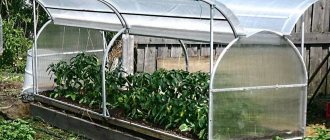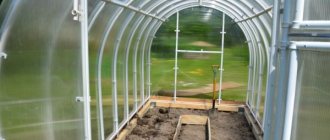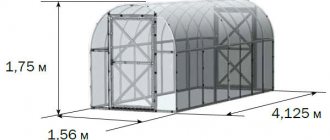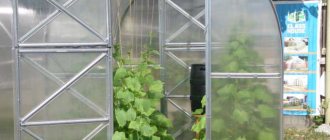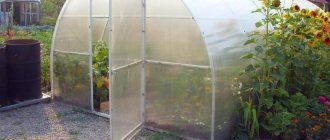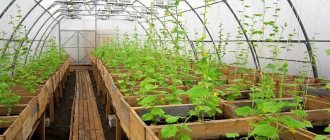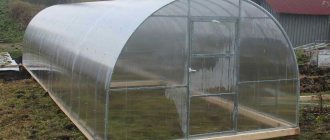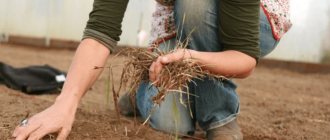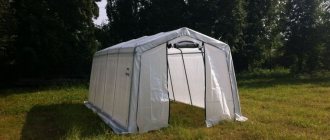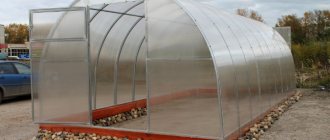At the dacha and in the garden, it is not possible to do without a greenhouse and a greenhouse in all regions: in the north, summer is too cool and short, so it has to be lengthened. And in more southern regions, you can either grow seedlings or get early/late vegetables and berries. That’s why these structures are popular: the costs are not very high, but the benefits are many. Moreover, greenhouses and greenhouses with your own hands can be built of any design, from any material, for any task.
Let’s immediately clarify how a greenhouse differs from a greenhouse. The greenhouse is maintained from the outside. It is small in size and cannot be entered. A greenhouse is a more solid structure in which you can stand at full height and work. The plants in it are maintained from the inside. That, in fact, is the whole difference.
What you need to know about greenhouses
Purpose
Like a greenhouse, a greenhouse is used to create a favorable microclimate when preparing seedlings or when fully growing tomatoes, cucumbers, cabbage and other plants.
In a broad sense, both structures are perceived as the same thing, although in fact a greenhouse is a small and unheated structure. A greenhouse is a larger building with a heating and ventilation system, which allows for the cultivation of many crops at any time of the year.
Design
The structure of greenhouses is quite simple. A frame is assembled from pipes, metal or wood, which is covered with film, polycarbonate, glass, acrylic and other light-penetrating materials. If the weight of the structure is very large, it is additionally installed on the foundation.
For ventilation, removable panels or opening transoms are provided. Heating is carried out using water heating with radiators, infrared heaters or hot air from heat sources outside the greenhouse.
Installation
Since sunlight is vital for plants, the greenhouse should be built on the south side. It is advisable to place it on a slope and closer to other buildings in order to protect it from the wind and have access to utilities. It is better to stay away from high fences and trees: they provide shade, and falling leaves reduce light transmission.
How to choose a place for a greenhouse on a site?
It is necessary to build a greenhouse on an area without slopes and isolated from groundwater, with good lighting and rich soil.
Experts recommend attaching greenhouses to the south wall of the house. The southwest and southeast sides are also suitable for this. When installing a greenhouse in an open area, it is recommended to place it from east to west, away from trees, bushes, buildings and fences.
- Where to install a greenhouse on the site
Is it possible to install a greenhouse on a standard plot of 6 acres? Quite if you take into account all the necessary factors.
The place where your greenhouse will stand must be level. The soil must first be compacted around the perimeter of the greenhouse being installed.
The yield of the crops grown and the strength of the chosen structure will directly depend on the location of the greenhouse on the site.
How to make a greenhouse with your own hands from agrofibre and reinforcement
youtube.com
- Assembly complexity: low.
- Foundation: not required.
- Cost: low.
- Variations: the frame can be replaced with plastic pipes, and the covering material with film.
The simplest design option, which is ideal for a small greenhouse. A frame made of reinforcement is installed directly on the bed, and agrofibre or, as it is also called, spunbond, is stretched over it. This material protects from the sun while retaining heat and moisture.
1. The dimensions of such a greenhouse are chosen arbitrarily, depending on the footage of available materials. For example, it is convenient to cut six-meter reinforcement in half. With such a length of arcs, the width of the greenhouse is about 80 cm. The arcs themselves should be installed in increments of 1.2–1.5 m.
teplica-exp.ru
2. Arcs are bent from reinforcement with a diameter of 8 mm. Next, drip irrigation tubes or an old hose are put on them, leaving 10–20 cm at each end so that it is convenient to insert the structure into the ground.
ebayimg.com
3. After marking the installation locations for the arcs, scraps of steel pipes or drilled wooden pegs 20–30 cm long are driven into the ground, and the reinforcement is inserted into them.
stopdacha.ru
4. Spunbond can be stitched on a sewing machine, forming pocket folds that fit directly onto the arches. Another option is to install plastic pipe guides on the sides of the beds and attach agrofibre to them using purchased clips or cut pieces of pipes. The covering material can eventually be easily lifted by simply removing them.
stblizko.ru
5. If desired, you can attach the arcs not to pipes driven into the ground, but to metal guides rigidly fixed at the edges of the base. This design will allow you to fold the greenhouse like an accordion, simply by moving the arcs.
must.kz
6. The free ends of the spunbond at the ends must be collected, tied in a knot and secured with a peg, earth or other means.
samara.kinplast.ru
Here are step-by-step video instructions.
Frames for greenhouses
When making a greenhouse frame, you can use different materials:
- Metal . Durable and strong, but heavy. To build a greenhouse from reinforcement, special tools are needed (to weld metal parts). The material is susceptible to rust, but this can be corrected by galvanizing it. If the structure falls (for example, from corrugated pipes), it will crush the plants.
- Wood , PVC, chipboard. It is easy to create such a structure; you only need basic construction skills. Wooden structures made from timber must be coated with special compounds to prevent beetles from infesting them.
- Plastic, propylene . Lightweight and durable. It bends well and can be used to create structures of various shapes. If a plastic greenhouse falls on crops, nothing will happen to them. The disadvantage is that it cannot withstand the load, bends and cracks.
Attention! To create a greenhouse, you will additionally need furniture corners, screws, clamps, etc. You can also make doors with handles.
How to make a greenhouse with your own hands from masonry mesh and film
dachadecor.com
- Assembly complexity: low.
- Foundation: not required.
- Cost: low.
- Variations: instead of film, you can use agrofibre, and make the door on a wooden frame.
A budget option for a greenhouse made from masonry mesh and regular film, which is quickly assembled and has a number of advantages. The design does not require a foundation; due to its elasticity, it is resistant to wind loads, and is also convenient for tying up plants from the inside. At the same time, by folding the mesh, you can get different sizes depending on your needs.
- Wooden beams, steel angles, pipes or channels are used as load-bearing posts. They are hammered at a distance of 1.2–1.4 m.
- The greenhouse arch is formed from two pieces of mesh laid overlapping. From below it is attached with wire to the posts, and from above it is fastened together with the same wire or plastic ties.
- To strengthen the structure, T-shaped supports made of wooden beams 50 × 50 mm are installed in the middle of the passage. If desired, they can also be driven into the ground.
- A film is put on a dome assembled from a mesh, which is held in place by strings of twine or rope stretched over it.
- The side walls are also made of film, which is folded up and attached to the dome with tape. In several places at the top and bottom, small windows are cut for ventilation of the greenhouse.
- The door is made on a wooden frame or made from the same film, which is cut and attached to the side wall with magnets in the manner of door mosquito nets.
Types of greenhouses and step-by-step instructions for their manufacture
The best projects are automatic types of buildings based on Arduino. They have an actuator (linear drive) to automatically open the door and ventilate. Of course, it could also be a simple thermal drive.
But in general, such greenhouses are equipped with everything necessary for autonomous operation. It will be very difficult to do this yourself. There are other ready-made greenhouse projects.
We offer you several homemade options with step-by-step instructions.
Arched (semicircular) greenhouse
You need to act step by step.
Drawings of arched greenhouses
Draw a drawing. Here are examples of drawings of an arched greenhouse:
Foundation
Beginning of construction - erection of the foundation. For this use:
- wooden beams - placed at a distance of 120-140cm, for a frame made of polypropylene pipes;
- tape - done if the frame is made of heavy materials.
The reinforcement frame needs supports so as not to touch the bottom of the trench
Frame
Next, build an arch from:
- masonry mesh, which is attached to the posts at the bottom and tied at the top;
- plastic pipes - welded or connected with couplings, adapters;
- steel professional pipe 2x2 cm - leave a distance of 100 cm, the arcs are fastened by welding;
- fiberglass reinforcement (diameter 8-12 mm) – easy to install.
Coating
The selected material is attached to the erected frame:
- film or spunboard - must be secured on top with twine or rope;
- polycarbonate - the cut sheet is secured using special self-tapping screws with thermal washers.
additional information
Door:
- film - made with magnets (like a mosquito net);
- wooden frame;
- metal pipe - mounted on hinges.
Windows for ventilation:
- in the film - holes are cut, any location is possible;
- wooden frame - can be opposite the door, in the roof, side walls:
- in a metal frame - a welded frame from a corner, placed opposite the door or in the roof, or in the sides, depending on the design of the greenhouse.
All these options are wind-resistant and convenient for tying up plants. It is possible to make greenhouses of any size (mini for seedlings, small, large). Film ones are a cheap option; they are used in the industrial production of vegetables and in dacha farming (it’s good to grow tomatoes and cucumbers).
The most expensive and labor-intensive option is a metal arch frame and polycarbonate, but such a greenhouse will last longer and looks more aesthetically pleasing.
Examples of creating various arched greenhouses
House-shaped greenhouse
Another very popular roof shape is gable.
Drawings of a greenhouse-house
Foundation
The need for a foundation depends on the weight of the frame. If it is light, then they do not make a capital base, but use:
- Steel corners 4x4 cm, driven into the ground - holes are first made to attach the frame posts, painted or filled with bitumen.
- Wooden blocks - the structure usually has a size of 3x6 m.
Frame
- Beam - fasten the bottom frame, sides, roof. The corners are given rigidity with additional segments. The sharp parts are rounded and wrapped in soft material.
- Galvanized profile - assembled from ribs and tied together.
- Plastic polypropylene pipe, connected with fittings and adapters.
- Profile made of plasterboard - does not require additional processing and is easy to bend.
Covering material
- Stretch film (like food film, but thicker) - wrap the frame in several layers, overlapping. They start with the gables, then the rest. Move from bottom to top to prevent rain from getting inside.
- Film or agrofibre - wrapped or glued.
- Polycarbonate - secured with special self-tapping screws with heat washers.
- Glass, as a rule, double-glazed windows are used for homemade greenhouses.
additional information
The door is on hinges in the side wall. The film is wrapped, covered with glazing bead or lath and cut through. The window is made similarly to the door. A heavy frame made of frames or metal will require a foundation. Usually they make a tape one.
Step-by-step instructions for making a greenhouse-house
- Old window frames (almost a free option) - their size determines the size of the greenhouse. Attached to frame or posts. The cracks are covered or clogged.
- The door is made using one of the frames or a balcony door is used. The windows will provide ventilation. It is better to stretch the film on the roof - the weight of the building is less. If you use frames for the roof, you need to strengthen the structure by placing supports.
- Metal frame - attached to bolts installed in the foundation before pouring. A frame is made from a channel or a double corner, racks (1.6-1.8 m) are welded to it and fastened together with segments. The roof is connected to the racks, and at the top - to the beam. A window is made in the roof or opposite the door.
The glass is inserted into frames formed by double corners. To improve thermal insulation, double-glazed windows are used.
A structure made of glass and metal is an expensive and labor-intensive option, but durable. You can build different types of greenhouses by combining the materials that are available.
Examples of creating greenhouse-houses
Dome greenhouse
It consists of triangles and hexagons. A foundation is required. This is a rather complex project - heavy assembly, high cost, labor-intensive calculations.
The advantage is strength + such a greenhouse transmits light well.
The frame is made of wood, profiles or pipes, covered with film, glass or polycarbonate is inserted.
Drawings of a domed greenhouse
They are built using the following technology:
- prepare triangles;
- fasten them with self-tapping screws, forming a dome;
- assembly starts from the bottom - you get the correct shape;
- the upper triangle is folding, provides ventilation;
- door - polygon or regular shape;
- the film is stretched after assembly, this provides an aesthetic appearance.
Examples of domed greenhouses
Greenhouse thermos
A thermos greenhouse (buried structure) will require a deep pit - about 200 cm. Its total height is 180 cm, width - 200-500 cm. A trench is dug along the edge of the bottom and walls are laid out. They provide a descent for installing stairs, pipes for air access, wall insulation, and waterproofing.
How to make a greenhouse with your own hands from stretch film with a wooden frame
stroydachusam.ru
- Assembly difficulty: average.
- Foundation: not required.
- Cost: low.
Another way to quickly build a greenhouse. A wooden beam is used as a frame, and stretch packaging film is used as a covering material. With a large number of layers, it transmits light a little worse than ordinary PVC film, but on hot days this is even a plus.
- The film is sold in rolls, so the dimensions of the greenhouse are selected according to the cutting of the timber and taking into account your wishes.
- For the base, steel corners 40 × 40 mm are used, in which holes for attaching the frame posts are pre-drilled. They can also be treated with bitumen or painted to extend their service life.
- The corners are driven into the ground, and pieces of timber are screwed to them with self-tapping screws. A lower frame, in turn, is attached to the beam, on which the side walls and roof are assembled. All corners are reinforced with additional inclined sections of timber.
- The door is assembled on a wooden frame in one of the side walls and installed on hinges.
- Film wrapping is done in parts, in several layers and overlapping. First, the gables are installed, then the roof slopes, and only then the walls. You need to start wrapping them from the bottom so that running rainwater does not get inside the greenhouse.
- After wrapping with glazing bead or river, the door and its outer contour of the door are trimmed, and then the film around the frame is cut through. In the same way you can make a window in the opposite wall.
Greenhouse lighting
A year-round greenhouse requires additional lighting equipment, because... natural light will not be enough.
Use:
- Classic lamps - at the junction of the roof and walls or high on the side.
- LED lamps are the best option for large areas (saving energy). They are durable and safe to use. Mounted at the highest point of the ceiling - maximum area coverage.
Automation of switching on - a block with a timer. It creates comfort by simulating daylight - it gives commands to the lamps to start and stop working. This greenhouse option is suitable for professionals for growing vegetables, flowers, and exotic plants all year round, including in winter.
For a seasonal building, additional lighting is not needed.
How to make a greenhouse with your own hands from old window frames
teplica-piter.ru
- Assembly difficulty: average.
- Foundation: desirable.
- Cost: minimal.
- Variations: you can combine frames with film to make a roof, side walls or doors.
The main advantage of this design is its low cost. Old window frames can be found, if not free, then for a nominal price. In addition, glass transmits light much better than film and polycarbonate. The windows already have vents for ventilation, and if you select a balcony block, you will also have a ready-made door.
- The size of the greenhouse depends on the size of the frames and the interior space you need. Aim for a width of about 2.5 m to give a passage of about 60 cm and two beds of 80–90 cm.
- Windows and glass have considerable weight, so it is advisable to install them on a solid base. This can be a shallow strip foundation, a massive wooden beam or a metal profile.
- A wooden frame or pillars are installed on the foundation at the corners, and frames are attached to them and to each other. The gaps between each block are covered with putty and clogged with strips of laminate backing or a thin wooden strip.
- A door is made in the front wall. Its role can be played by one of the windows, a balcony door or a wooden frame covered with film. Ventilation is provided through window vents.
- To reduce weight, it is better to make the roof from wooden beams and film. You can use the same window frames, but in this case you will have to reinforce the structure with supports in the middle of the passage so that it can withstand a lot of weight.
Materials for greenhouses
The best greenhouse designs are made from polycarbonate, double-glazed windows and low-density polyethylene (HDPE). They are inexpensive and can even be lying around somewhere in the barn (for example, window frames). Let's consider the characteristics of the materials:
| Options | Polycarbonate | Glass | Film ( HDPE) |
| Installation complexity and weight | Lightweight, self-supporting material. When choosing it, you can reduce the number of frame parts without creating a foundation. | It is a heavy material that requires a strong frame and base. | The lightest material presented. It can even be carried away by the wind, so it needs to be attached to the frame. |
| Operational period | It has a long service life of 20-25 years. Manufacturers usually give it a 10-year warranty. The material itself is an element of the supporting structure. After installation, it does not deform or warp. | It will last a long time if it is protected from hail, snow, etc. Such a greenhouse can be placed under a canopy. | It has a short service life (maximum 2-3 years). Polyethylene deteriorates when exposed to sunlight. |
| Soundproofing | It has a honeycomb structure. This muffles wind noise. | If a glass greenhouse is poorly installed, a draft will penetrate inside and the glass will ring and rattle. | Virtually no noise reduction. In strong winds the film begins to rustle a lot. |
| Aesthetics | Looks very modern and attractive. To some extent, it can even become the decor of the site. | When installed well, it looks very aesthetically pleasing. | It looks aesthetically pleasing only at first, then it begins to deteriorate and fade under the sun. |
| Safety | Does not break or crack when dropped or hit. Stronger, but at the same time lighter than glass. | If the glass breaks, it can cause injury. Therefore, during installation work, it is recommended to take care of safety equipment (rubber gloves, thick shoes, etc.). | Completely safe. |
| Care | The accumulated dust is almost invisible. If desired, it can be washed off with plain water from a hose. | After rain, cloudy stains may remain on the surface. They can only be eliminated by using special detergents. | When dirty, this material cannot be washed, because... There will be stains on it that prevent the penetration of sunlight. |
| Microclimate inside | It prevents heat loss, which creates a greenhouse effect. The resulting condensate flows down the walls without getting on the plants. It transmits and diffuses light well. | Retains heat worse than polycarbonate. It transmits rays well, but does not scatter them. If the glass is of poor quality, it can work as a magnifying glass, which is detrimental to crops, because sunburn will appear. | The new material retains heat well and allows the sun to pass through. However, the very next season it becomes thinner and cloudier. |
Spunbond is also often used. This is a breathable covering material. It allows oxygen and necessary moisture to pass through well. At the same time, it does not get wet and does not release heat. Cuts with scissors and can be washed.
Spunbond
Previously, we already looked at frames for greenhouses, and now let's see how to attach the materials that we talked about in the table.
How to make a greenhouse with your own hands from film and polypropylene pipes
maja-dacha.ru
- Assembly difficulty: average.
- Foundation: not required.
- Cost: low.
- Variations: the film can be replaced with agrofibre or polycarbonate
A greenhouse made of polypropylene pipes attracts with its simplicity, reliability and low price. The materials are sold at any hardware store, and assembly does not require any special skills or tools. You can even do without a soldering iron if you connect the pipes not with fittings, but with through bolts.
- As always, sizes are selected based on needs and available materials. Polypropylene pipe is usually sold in 4 m sections, and it is easy to cut and splice using couplings.
- The first step is to calculate the length of the pipe and the number of fittings required. It’s better to take it with a reserve so that you don’t have to run to the store later.
- The main parts are soldered from pipes, tees and crosspieces - arches with crossbars and longitudinal inserts.
- Next, the greenhouse is assembled from the prepared parts. If a soldering iron is not at hand, you can use bolts with nuts and washers to connect, which are inserted into pipes drilled through.
- The film is secured to the edges of the frame using purchased pipe clamps or homemade clips made from slightly larger diameter pipes cut along sections.
Plumbing, electricity, greenhouse heating
After the greenhouse frame, covering, and ventilation are completed, you can begin installing the electrical network, heating and water supply.
Considering that the humidity in the greenhouse will be high, all electrical work must be performed taking into account the requirements of the relevant standards and rules for performing special work.
Stove heating, electric energy, or gas can be considered as a heat source for the room. The issue of efficiency will depend on the regional location of the facility.
For productive work, it is advisable to bring water into the greenhouse. For this, a plastic pipe with a diameter of 1.5 inches is usually used. The riser is located at the entrance to the room.
How to make a greenhouse with your own hands from film with a wooden frame
legkovmeste.ru
- Assembly difficulty: average.
- Foundation: not required.
- Cost: low.
- Variations: the film can be replaced with agrofibre or polycarbonate.
A classic version of a greenhouse, used for decades and not losing popularity. Wooden beams are easy to process, have low weight and sufficient strength, and also retain heat well. The structure does not require a capital foundation - you can get by with a frame made of timber of a larger cross-section or use steel corners as a base.
- The standard cutting of timber is 6 m, so they start from this figure. Most often, greenhouses are made 3 × 6 m, but if desired, the dimensions can be either reduced or increased. The finished project with material calculations is available at this link.
- The assembly of the frame is the same as for a greenhouse made of stretch film. Steel corners are driven into the ground at intervals of about 1 m at the points where the posts are attached. In each of them, two holes are drilled for self-tapping screws or one for M8 or M10 bolts.
- Vertical posts are fixed to the corners along the entire perimeter, which are tied with an upper contour made of timber. To add rigidity in the corners, one jib is added on each side
- Triangular roof trusses are installed and secured opposite the racks. The slope angle is selected depending on the snow load. So, if there is a lot of snow in your region, the angle of inclination should be greater (the roof is higher and sharper).
- The door and window for ventilation are assembled on wooden frames and installed in the front and rear walls, respectively.
- At the end, the frame is covered with film, which is attached to the beam using a lath stuffed on top. All sharp parts on the wood are rounded off or covered with a soft material so that the film does not tear during operation.
Types of greenhouses
The most reliable and convenient types of greenhouses that you can make yourself:
| Photo | Design |
| Breadbox . It opens like a bread box, hence the name. It is convenient because the lid does not fall and does not need supports. | |
| Arched . A simple and budget-friendly greenhouse scheme. The arcs are stuck into the ground and covered with film or spunbond. Easy to assemble and disassemble without special skills. For manufacturing, you can use pipes after bending. | |
| Thermos . The greenhouse is dug into the ground. There is only a cover on the surface for access to the plants and ventilation. Thanks to this, heat is better retained inside. | |
| Butterfly . Arch or house shapes. A special feature is that the two doors hinge outward, reminiscent of wings. Access is provided from both sides. Doors can be made of polycarbonate. | |
| House (gable) . The boards are connected at the ridge. Covered with film or covering material. This type is quick and easy to install, can be portable, but is not very stable. Therefore, it is most often used as a temporary shelter. | |
| Single-pitch . The design resembles a chest with a flat lid. To ventilate, props are placed under the roof. |
The listed varieties can be upgraded by adding additional elements.
The most important thing is to think through the entire scheme step by step.
Helpful information! You can find a lot of old things in the attic and barn that are perfect for creating a greenhouse. For example, window frames, old beds, drywall, polypropylene or aluminum profiles, etc. You just need to use your imagination to figure out how to make them a shelter for plants without investing money in it.
Let's look at the most popular materials for frames and shelters. And also, below are step-by-step instructions on how to make a greenhouse with your own hands from various materials.
How to make a polycarbonate greenhouse with a metal frame with your own hands
- Assembly difficulty: high.
- Foundation: required.
- Cost: high.
- Variations: the foundation can be made of wooden beams or use steel reinforcement, angle or pipes driven into the ground.
The most popular and modern version of the greenhouse. This design is much more expensive than others and is difficult to manufacture, but it will last for decades. Polycarbonate can withstand the open sun for 10–12 years, and the frame made of a profile steel pipe is almost eternal.
1. The standard size of polycarbonate is 2,100 × 6,000 mm, so it is convenient to cut it into four or two parts with dimensions of 2.1 × 1.5 m or 2.1 × 3 m, respectively. Such pieces will be optimal for a greenhouse measuring 3 × 6 meters.
2. For reliable fastening and distribution of wind loads, a foundation is made under the greenhouse. This can be a shallow strip foundation, a frame made of antiseptic-treated wooden beams, or steel corners driven into the ground.
YouTube channel of Evgeniy Kolomakin
3. The design of the greenhouse consists of an arch, which is formed using arcs from a profiled steel pipe 20 × 20 mm, located at a distance of one meter from each other.
4. The arcs are fastened together by longitudinal sections from the same pipe, which are connected by welding.
5. A door is installed at the front end: a frame measuring 1.85 × 1 m is welded from a pipe, which is attached to the frame on hinges. A window for ventilation measuring 1 × 1 m is made according to the same principle and is located at the rear end.
6. Covering with polycarbonate begins from the ends. The sheet is cut in half, attached to the profile using special self-tapping screws with thermal washers, and then trimmed along the contour of the arc with a sharp knife. After this, the side wall sheets are installed.
Foundation
The type of greenhouse chosen determines its foundation. First, markings are made - the sides form a right angle. For a seasonal structure, a wooden base made of timber (10x15 or 15x15 cm) treated with an antiseptic or water-repellent compound is suitable to last longer. Place it on the ground, but preferably on a cushion of compacted sand or on concrete slabs.
For a permanent building you will have to dig a pit. You can make a strip foundation - a trench 30x30 cm. Sand is poured onto the bottom, crushed stone on top (all 50-70 cm thick). They put up formwork from boards, lay roofing felt and fill it with concrete. It needs to be pierced with a shovel and knocked on top to remove the air. The base is raised above the ground by 20-50 cm. Support posts or pieces of metal corners are embedded in the foundation.
How to make a polycarbonate greenhouse with a galvanized profile frame with your own hands
techkomplect.ru
- Assembly difficulty: average.
- Foundation: not required.
- Cost: low.
A simpler and more affordable option for a polycarbonate greenhouse. It does not use expensive metal pipe that needs to be welded. And galvanized profiles for plasterboard systems are used as frame material. They are easily cut with metal scissors and fastened with ordinary self-tapping screws.
- When choosing sizes, as usual, we start from the parameters of polycarbonate sheets. Since the profiles lose rigidity when bent, it is better to choose a gable greenhouse rather than an arched one.
- By analogy with arches made of a metal pipe, a frame made of galvanized profile is assembled from ribs in the form of a house.
- The assembled modules are installed on a frame made of wooden beams and tied together with sections of profiles. Doors and a window for ventilation are made in the front and rear walls.
- At the end, the frame is sheathed with polycarbonate sheets, which are secured using special self-tapping screws with plastic thermal washers.
Design features
A greenhouse made into reality, made with one’s own hands, occupies an important place on a summer resident’s plot. A greenhouse made by yourself does not mean that it will be less effective in its functionality.
Photos and drawings of greenhouses for making with your own hands can be viewed and studied on thematic websites. The design of the greenhouse and its shape will depend on the purpose of the object.
The most popular materials for the construction of greenhouses are fiberglass or galvanized metal profile pipes, which serve as a load-bearing role for the structure. Glass, polyethylene film, polycarbonate can be used as a coating.
How to make a glass greenhouse with a metal frame with your own hands
juliana.ru
- Assembly difficulty: high.
- Foundation: required.
- Cost: high.
- Variations: to make the structure lighter, you can make the top from polycarbonate or film.
The most correct, but rather labor-intensive and expensive option for a greenhouse. The main advantage of glass is its excellent light transmittance and durability. However, due to the heavy weight of the structure, a strong metal frame and foundation are required. In addition to arranging a strip foundation, the difficulty also lies in the need to use welding.
- When it comes to choosing sizes, a glass greenhouse is no exception - everything is strictly individual and taking into account the available materials.
- The impressive weight of glass and metal frame requires a full foundation. Usually a trench 30 cm deep and 20 cm wide is dug around the perimeter, wooden formwork 20 cm high is installed on top and the whole thing is filled with concrete. Also, before pouring, anchor bolts are inserted into the formwork to secure the frame.
- A metal channel or corner is attached to the resulting base using anchors. Then racks 1.6–1.8 m high are welded to this frame from two folded corners 45 × 45 mm. At the top they are fastened with longitudinal sections of the corner.
- Next, rafters from the same double corners are placed on the resulting box. At the bottom they are welded to the posts, and at the top - to another corner, which acts as a ridge beam.
- A door is inserted into one of the walls, and a window is installed in the lid or wall for ventilation.
- The glass is installed in the frames obtained by using double corners and secured with homemade gluers - thin aluminum or steel plates bent in the shape of the letter Z. The gluer is attached to the corner with one hook, and to the glass with the second.
Video description
The video shows a comparison of an attached and a free-standing greenhouse:
The advantage of this option is the reduction in material costs due to that very wall. It is important to attach the frame to its plane as much as possible, making the joining points strong and reliable.
As for materials, there are no restrictions here either. All of the products described above can be used to assemble a frame structure. And such a greenhouse can be covered with films, glass or polycarbonate.
Greenhouse attached to the wall of the house Source pinterest.com
How to make a dome greenhouse with your own hands from film with a wooden frame
pinterest.com
- Assembly difficulty: high.
- Foundation: desirable.
- Cost: high.
- Variations: the film can be replaced with polycarbonate or glass, and the frame can be made of profiles or pipes.
A domed or geodesic greenhouse attracts primarily with its unusual appearance: it consists entirely of many triangles and hexagons. Other advantages include high structural strength and best light transmittance. The geodesic dome has only one drawback: it is difficult to manufacture.
- The dimensions of such a greenhouse are selected individually, based on the required area. Since the frame design is quite complex, calculations are the most time-consuming part of the project.
- In order not to get confused and take into account all the nuances, it is convenient to carry out the calculation using a special calculator. In it you can set the dimensions, select the “thickness” of the frame and get a list of all the necessary parts for assembly with dimensions, as well as their approximate cost.
- Regardless of its dimensions, a domed greenhouse is highly durable and is not afraid of winds, so there is no need to make a foundation for it. However, since the construction of a structure is very labor-intensive, it is rational to extend its service life and equip a lightweight strip foundation for attaching the frame.
- The ribs of the structure consist of triangles, which, in turn, are assembled from a wooden batten according to a template. First you need to prepare the required number of such triangles.
- The greenhouse is assembled like a magnetic construction set from childhood. Starting from the bottom, rows of triangles are assembled one after another, which are fastened together using self-tapping screws and form a dome. If everything is calculated correctly, it will close at the top and will be perfectly shaped.
- One of the triangles in the roof is made folding or removable to provide ventilation. The door is either installed in a polygon shape, or made in a traditional shape with a mortise frame.
- The film covers the finished dome or is stretched over each triangle at the assembly stage. In the first case, it will be easier to replace the film when it breaks. The second one gives a more aesthetic appearance. Which one to choose - decide for yourself.
What to cover
The main covering material for greenhouses and greenhouses is film. It is used on both small and large-sized structures. Glass was previously used for year-round use, but its high price and fragility led to the fact that it is used very rarely - the resulting shelter is expensive. And the large weight of the glazing requires a solid frame.
There are two new items. The more familiar polycarbonate, which is used for gazebos and canopies, and the relatively new one is spunbond non-woven covering material.
Now about everyone in more detail.
Film for greenhouses and greenhouses
Available in different polymers and different thicknesses. The most common are polyethylene and polyvinyl chloride. There are also reinforced ones.
Polyethylene films are the most inexpensive, but they are also the most short-lived. Even with the most careful treatment, they do not last more than a year: they become fragile under the influence of ultraviolet radiation, and the cold kills them. However, they are most often bought: cheap.
Available in sleeve form. By cutting it on one side, we get double width. There is no point in using uncut film: the service life will remain the same, but the consumption will be exactly twice as much. There is only one feature: the film breaks quickly along the fold. It is difficult and almost useless to seal it afterwards: the tape sticks very poorly to a dusty surface. Therefore, this fold is taped with tape before use. It turns out reliable.
Thickness and types
The optimal thickness of polyethylene film for summer cottages and greenhouses is 150 microns. If you take a thicker one, its service life will still be one season, but 150 characteristics will be enough.
The reinforced film differs in appearance: the cage is clearly visible
Reinforced film is more durable. Manufacturers provide a 3-year warranty. It is easy to distinguish by its appearance: it is checkered. Fibers of other polymers or the same polyethylene, but processed differently, are woven into polyethylene fabric. Thanks to stronger fibers, such a film greenhouse can withstand wind and snow loads well (to a certain extent). Reinforced film is available in different densities; for greenhouses and greenhouses at dachas and personal plots, 120 g/m2 to 200 g/m2 is more suitable.
There are also polyvinyl chloride films. They can be used for up to 7 years. But they are expensive. The material is also good because it transmits sunlight well (80-90%) and almost does not transmit infrared light (5-10%), that is, it does not allow the greenhouse to cool down overnight. If you need a warm greenhouse that maintains temperature well at night, this is your choice.
There are also films called perennial. Most often it is polyethylene with various additives. Some other polymers are less common. Typically, perennial films have some special properties:
- less destroyed by ultraviolet radiation - light-stabilizing;
- transmits less thermal radiation - heat stabilizing;
- prevents condensation drops from forming on the film - hydrophilic;
- reflects thermal radiation, glows in the dark, absorbs ultraviolet light - these properties depend on the type of additives, but are called light-converting.
These properties can be combined in one film. This is how you can find a long-term hydrophilic heat-stabilizing film, etc. One more thing. Such films usually have some kind of tint: yellow, greenish, blue...
Perennial films have different colors
When choosing a multi-year film, be sure to check its service life. It can be from two seasons to 3 years. Note. If it says 2 seasons, it means it needs to be removed for the winter. If 2 years, then this is a film for year-round use. Sellers often manipulate these concepts, saying that two seasons mean two years.
See photo reports on the construction of greenhouses with your own hands here.
Polycarbonate
This cellular material has many advantages: it is lightweight, transmits light well, retains heat, bends, and is easy to install. The disadvantage is the relatively high cost. However, if the greenhouse will be used for more than one year, such investments will pay off: even without additional heating, the growing season will increase significantly.
But polycarbonate varies in structure and thickness. The most commonly used types in the construction of greenhouses are in the table.
The structure of polycarbonate and its thickness
For normal conditions (average snow load and wind), single-chamber sheets are used to cover greenhouses. For regions with a lot of snow, it makes sense to take reinforced ones.
The optimal thickness of the sheets is 6 mm or 8 mm. You shouldn’t take less: the sheets are too fragile and their characteristics are not very good (see table). Polycarbonate 4 mm thick can be placed on small greenhouses. It will not withstand heavy loads.
Characteristics of polycarbonate of different thicknesses
Polycarbonate still needs to be fastened correctly: the cells must be oriented from top to bottom, the open edges must be sealed with a special tape or tape, secured with special thermal washers or bolts with a large metal washer, under which a rubber or plastic lining must be placed.
Spunbond
This is no longer the same material. There are many brands: Agril, Lutrasil, Spantex, Agrospan, AgroSUF, etc. It’s just that Spunbond appeared first and now all similar materials are called that way, and also “non-woven covering material” or “agrofibre”. This is a non-woven polypropylene fiber that has unique characteristics: it allows air, light and moisture to pass through, while simultaneously saving plants from overheating or freezing. Feedback from a practice on using this material in a video.
Agrofibre is characterized by density. The lowest is 17 kg/m3, the highest is 60 kg/m3. For seasonal greenhouses and greenhouses from spring to autumn, the optimal density is 30-40 kg/m3; for winter ones, 60 kg/m3 is needed.
Read about how to organize drip irrigation here.
Passive solar greenhouse, Invermere, Canada
The design of this greenhouse is very atypical: it has an insulated back wall and roof. There is also a complex of high- and low-tech systems installed here, thanks to which such a greenhouse can be used in cold, sunny climates.
The greenhouse designers decided not to build a “transparent box” and abandoned the north-facing glass wall to avoid heat loss and lack of light. Instead, they built a concrete thermal storage wall and floor, and insulated the back wall and ceiling to keep the heat in the room.
Another special feature of the greenhouse is that it has a geoinformation energy saving system installed, with the help of which heated air moves from top to bottom and is directed into the ground under the greenhouse. This air can then be returned back and used to heat the greenhouse.
